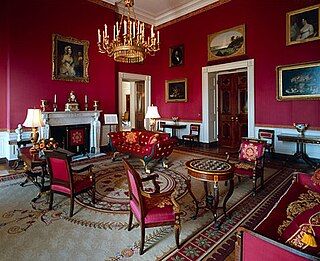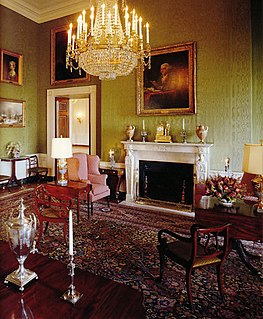History
John Adams, the first President to live in the White House, used this room as a laundry room; at that time it was said to have been filled with "Tubs, Buckets, and a variety of Lumber"; at the time, lumber meant "miscellaneous useless articles that are stored away". During Millard Fillmore's presidency (1850–1853), Congressional funding was requested to establish a White House library. The library was established during the Fillmore presidency, spearheaded by the First Lady, Abigail Fillmore. This library was originally in the Yellow Oval Room and was maintained there until 1929 when it was moved to its current location by the Hoover administration. By the time of this relocation there were almost no books remaining in the mansion, so the American Booksellers Association donated books and continued to do so in subsequent administrations. The room saw slight modifications until the Truman reconstruction in 1952, when the room was paneled in salvaged timbers from the White House's former timber frame. These were left unpainted until the administration of John F. Kennedy, when decorator Stéphane Boudin recreated the room as a painted Federal style parlor.

John Adams was an American statesman, attorney, diplomat, writer, and Founding Father who served as the second president of the United States from 1797 to 1801. Before his presidency he was a leader of the American Revolution that achieved independence from Great Britain, and also served as the first vice president of the United States. Adams was a dedicated diarist and regularly corresponded with many important figures in early American history including his wife and adviser, Abigail, and his letters and other papers are an important source of historical information about the era.

Millard Fillmore was the 13th president of the United States (1850–1853), and the last to be a member of the Whig Party while in the White House. A former U.S. Representative from New York, Fillmore was elected the nation's 12th vice president in 1848, and succeeded to the presidency in July 1850 upon the death of President Zachary Taylor. He was instrumental in getting the Compromise of 1850 passed, a bargain that led to a brief truce in the battle over slavery. He failed to win the Whig nomination for president in 1852; he gained the endorsement of the nativist Know Nothing Party four years later, and finished third in that election.

Abigail Powers Fillmore, wife of Millard Fillmore, was the First Lady of the United States from 1850 to 1853 and the Second Lady of the United States from 1849 to 1850.
To stand out, an unusual lighthouse clock was made by Simon Willard to commemorate the visit of the Marquis de Lafayette to the United States in 1824–1825. A likeness of Lafayette appears in a medallion on its base.
The Library provides access to a men's lounge and restroom.

The Oval Office is, since 1909, the working office space of the President of the United States, located in the West Wing of the White House, Washington, D.C.

The Resolute desk is a nineteenth-century partners' desk used by several presidents of the United States in the White House Oval Office as the Oval Office desk. It was a gift from Queen Victoria to President Rutherford B. Hayes in 1880 and was built from the English oak timbers of the British Arctic exploration ship HMS Resolute. Franklin Roosevelt requested the addition of a door with the presidential seal to conceal his leg braces. Many presidents since Hayes have used the desk at various locations in the White House.

The Red Room is one of three state parlors on the State Floor in the White House, the home of the President of the United States in Washington, D.C., in the United States. The room has served as a parlor and music room, and recent presidents have held small dinner parties in it. It has been traditionally decorated in shades of red. The room is approximately 28 by 22.5 feet. It has six doors, which open into the Cross Hall, Blue Room, South Portico, and State Dining Room.

The Green Room is one of three state parlors on the first floor of the White House, the home of the President of the United States. It is used for small receptions and teas. During a state dinner, guests are served cocktails in the three state parlors before the president, first lady, and a visiting head of state descend the Grand Staircase for dinner. The room is traditionally decorated in shades of green.

The Vermeil Room is located on the ground floor of the White House, the official residence of the President of the United States. The room houses a collection of silver-gilt or vermeil tableware, a 1956 bequest to the White House by Margaret Thompson Biddle. Portraits of American First Ladies hang in the room.

The China Room is one of the rooms on the Ground Floor of the White House, the home of the President of the United States. The White House's collection of state china is displayed there. The collection ranges from George Washington's Chinese export china to Bill Clinton's ivory, yellow, and burnished gold china. The room is primarily used by the first lady for teas, meetings, and smaller receptions.

The Diplomatic Reception Room is one of three oval rooms in the residence of the White House, the official home of the President of the United States. It is located on the ground floor and is used as an entrance from the South Lawn, and a reception room for foreign ambassadors to present their credentials, a ceremony formerly conducted in the Blue Room. The room is the point of entry to the White House for a visiting head of state following the State Arrival Ceremony on the South Lawn. The room has four doors, which lead to the Map Room, the Center Hall, the China Room, and a vestibule that leads to the South Lawn.

The Map Room is a room on the ground floor of the White House, the official home of the President of the United States.

The Cross Hall is a broad hallway on the first floor in the White House, the official residence of the President of the United States. It runs east to west connecting the State Dining Room with the East Room. The room is used for receiving lines following a State Arrival Ceremony on the South Lawn, or a procession of the President and a visiting head of state and their spouses.

The Yellow Oval Room is an oval room located on the south side of the second floor in the White House, the official residence of the President of the United States. First used as a drawing room in the John Adams administration, it has been used as a library, office, and family parlor. Today the Yellow Oval Room is used for small receptions and for greeting heads of states immediately before a State Dinner.

The Treaty Room is located on the second floor of the White House, the official residence of the President of the United States. The room is a part of the first family's private apartments and is used as a study by the president.

The Jacqueline Kennedy Garden is located at the White House south of the East Colonnade. The garden balances the Rose Garden on the west side of the White House Complex.

The Cabinet Room is the meeting room for the cabinet secretaries and advisors serving the President of the United States. The body is defined as the United States Cabinet. The Cabinet Room is located in the West Wing of the White House, adjoining the Oval Office, and looks out upon the White House Rose Garden.

The Roosevelt Room is a meeting room in the West Wing of the White House, the home and main workplace of the President of the United States. Located in the center of the wing, near the Oval Office, it is named after two related U.S. presidents, Theodore Roosevelt and Franklin D. Roosevelt, who contributed to the wing's design.

The Grand Staircase is the chief stairway connecting the State Floor and the Second Floor of the White House, the official home of the President of the United States. The stairway is primarily used for a ceremony called the Presidential Entrance March. The present Grand Staircase, the fourth staircase occupying the same general space, was completed in 1952 as a part of the Truman White House reconstruction. The Grand Staircase is entered on the State Floor from the Entrance Hall.

The North Lawn at the White House in Washington, DC, is bordered on the north by Pennsylvania Avenue with a wide view of the mansion, and is screened by dense plantings on the east from East Executive Drive and the Treasury Building, and on the west from West Executive Drive and the Old Executive Office Building. Because it is bordered by Pennsylvania Avenue, the White House's official street address, the North Lawn is sometimes described as the front lawn.

The South Lawn at the White House in Washington, DC, is located directly south of the house, and is bordered on the east by East Executive Drive and the Treasury Building, and on the west by West Executive Drive and the Old Executive Office Building, and along its curved southern perimeter by South Executive Drive and a large circular public lawn called The Ellipse. Since the address of the White House is 1600 Pennsylvania Avenue NW, and the North Lawn faces Pennsylvania Avenue, the South Lawn is sometimes described as the back lawn of the White House.

The West Sitting Hall is located on the second floor of the White House, home of the President of the United States. The room is entered from the second floor Center Hall on the east side of the room. The room features a large lunette window on the west wall looks out upon the West Colonnade, the West Wing, and the Old Executive Office Building. The room is used by first families as a less formal living room than the Yellow Oval Room.

Zuber & Cie, founded as Jean Zuber et Cie is a French Manufacture de Papier Peints et Tissus company which claims to be the last factory in the world to produce woodblock printed wallpapers and furnishing fabrics.





























